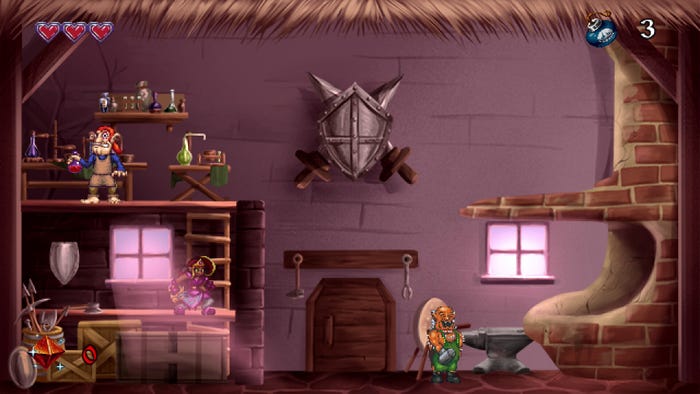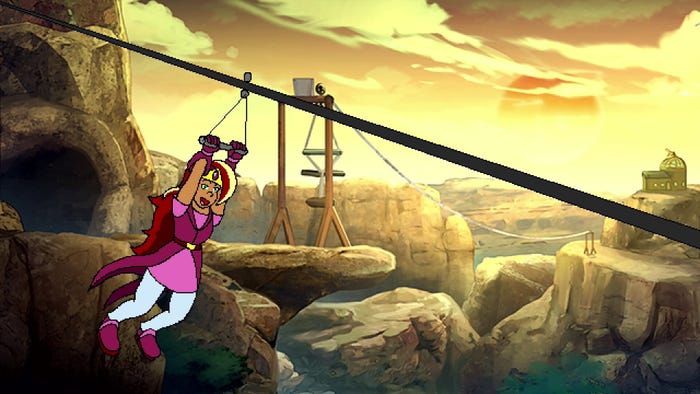Trending
Opinion: How will Project 2025 impact game developers?
The Heritage Foundation's manifesto for the possible next administration could do great harm to many, including large portions of the game development community.

It’s nothing new in the video game industry to hear that a developer was inspired by Nintendo’s The Legend of Zelda series. But what if they’re inspired by two games that Nintendo itself would rather stay buried in the annals of history?
Seedy Eye Software is answering that very question. Its debut game, Arzette: The Jewel of Faramore, proudly draws inspiration from Link: Faces of Evil and Zelda: Wand of Gamelon, both by Phillips Interactive Media. These two games for the short-lived CD-i system are well-known for their clunky gameplay and notoriously awkward animated cutscenes with over-the-top voice acting. With Arzette, creator Seth “Dopply” Fulkerson has faithfully replicated that look and sound, going so far as to bring in artists and voice actors who worked on the original games.
One might easily misunderstand Fulkerson’s intent, thinking that Arzette is meant to poke fun at its inspiration by simply delivering more of what those games offered, or perhaps exaggerating their flaws for comedic effect.
However, he tells Game Developer that this new game is meant to be a sincere labor of love. He wants to make a tongue-in-cheek homage to these infamous (yet oddly charming) games—and shine a light on their untapped potential.
The journey began in 2020 when Fulkerson, a hobbyist developer since he was 12 years old, took on the challenge of remastering the two CD-i Zelda titles as a personal quest to see if he could finish a game project with reasonable scope to “satisfy an in-joke between friends.” The response was greater than he anticipated. “I knew that they and some of their mutual friends would get a kick out of it, but I did not expect the overwhelmingly positive response,” he says.
Doing a fan-made remaster meant becoming intimately familiar with how the games worked. This included poring over any information he could find regarding their development process, from design documents to director interviews.

Image via Seedy Eye Software/Limited Run Games.
As a result of his research, Fulkerson gained a newfound respect for the developers at Phillips Interactive Media. “The limitations the games suffered thanks to the hardware, budget and time constraints became painfully obvious,” he says, “I found it very inspiring to see how much [director Dale DeSharone] and his team accomplished with so little. There is a handcrafted charm to the games. They are hand-animated, hand-drawn, with brilliant music, designed in a surprisingly non-linear way that encourages you to explore them.”
“Maybe the artwork on display wasn’t always the highest quality, but more than anything, I think the games are memorable experiences that stick with people,” he says. “Though they have many, many flaws, I truly believe there is innate potential in the games. Making a new game in the same style, with improvements to the core gameplay, was an irresistible idea.”
Making a high-quality spiritual successor to such titles meant capturing their charms while jettisoning their negative elements. Thankfully, Fulkerson knew immediately what was worth retaining and what to discard for Arzette. “I wanted to keep the same core art style and gameplay loop—hand-painted level backgrounds, traditional animation produced in a similar style, linear levels with non-linear exploration that depended on power-up acquisition, and an appropriate soundtrack—while getting rid of anything that was too obtuse or a result of hardware limitations,” he explains.
Apart from its inspiration, Arzette is more than just a spiritual successor. It also carves out its own identity, taking inspiration from various other influences in Fulkerson’s life for its design and world. “As a lifelong artist who created many books and ‘design docs’ as a child, many of the game's characters I had come up with previously [but] didn’t have a place for them until now,” he says. “It was indeed a challenge to stay true to the style of the games that inspired Arzette while lightly modernizing it and making sure the game had its own identity.”
It was important, he says, to not be cynical in the development process. “Part of it was writing the game earnestly, with no overtly winky references or cynicism, and the other part was treating the game like it was a lost ‘third game’ for a non-existent, slightly more graphically advanced ‘Philips CD-i 2’, with artwork, animation, and music contributed by people who were just as passionate for the source material as I was.”
The story follows the titular Arzette, the spunky, good-natured princess of Faramore, as she journeys to stop the evil demon king Daimur from conquering her kingdom. Along the way, she encounters all sorts of characters that are as strange or over-the-top as those from the CD-I games. It’s a narrative and universe that isn’t afraid to be silly without sacrificing sincerity.
“I am fortunate that my producer and writing partner, Audi Sorlie, has a remarkably similar sense of humor and style to mine,” says Fulkerson. “He helped ensure the game stuck to my aim of writing that felt sincere and true to the games that inspired it. The world and characters of Arzette can be quite strange, but they don’t know that. It was important to me that the game itself never called that out, that the characters were self-confident and living what they think is a perfectly normal existence.”
One of the biggest aspects of Arzette that makes it feel like a genuine love letter to Zelda’s CD-i outings is the additional talent behind it—most notably, Jeffery Rath and Bonniejean Wilbur, who voiced Link and Zelda respectively in those games decades earlier, along with original background artist Rob Dunlavey.
Fulkerson followed some leads and reached out to each of them with an earnest pitch. “I made it clear what Arzette was, that I was not making a joke game, that this was a passion project, and that I’d love to work with them,” he says. “It was a delight. They all understood what the project was and had a fun time. It was a surreal but incredibly gratifying experience to hear them record lines and provide artwork that was remarkably faithful to what they had done 30 years prior.”
Getting the talent on board was one thing, but then came the million-dollar question: Would a unique project like Arzette be able to find a publisher who could understand what Fulkerson was going for and be willing to take a chance on it?

Image via Seedy Eye Software/Limited Run Games.
Fulkerson and Sorlie pitched Arzette to several publishers but didn’t get any bites. They thought about taking the game to Kickstarter, but then, in a stroke of good timing, Sorlie landed a producer role at Limited Run Games, putting him in a position to pitch the game directly to CEO Josh Fairhurst. After seeing a very early version of the shopkeeper’s cutscene animation in the vertical slice, it was clear to Fairhurst the type of game Fulkerson and crew were setting out to make. He decided to strike a deal with Seedy Eye Software.
"At Limited Run Games, I want to fund and publish the games no one else would even dare to consider,” says Fairhurst. “Arzette fit nicely into this because 'spiritual successor to the Zelda CD-i games' was a pitch that would make most publishers blacklist you."
According to Fulkerson, Limited Run has been “amazingly supportive.” “I literally could not imagine working with anyone else,” he says. From the very beginning, they knew what Arzette was and did everything necessary to make it a reality.”
Ultimately, what is Fulkerson’s goal for Arzette: The Jewel of Faramore?
“My most important goal was to create something that I personally felt was a fun, worthy spiritual successor that constantly surprises the player,” he answers. “My secondary goal was to prove that there is potential in even the most lambasted of video games, and to show what those infamous games could have been in more favorable circumstances.”
“I am a fan of under-loved, under-appreciated games, and I hope that more of those types of games get the love and attention they deserve."
You May Also Like